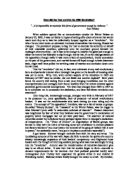How and why did the Tsar Nicholas II Survive the 1905 Revolution?
There were many various factors which contributed to Tsar Nicholas II surviving the 1905 Revolution. One could say these worked together to achieve the Tsar’s survival, however perhaps the most influential of these was the loyalty of the Russian army during the period. Without the reliance he had upon the Army, it could be questioned as to whether The Tsar would have survived the revolution.
The procession of workers whom marched to the Winter Palace led by Georgi Gapon where by 100 workers were killed and some 300 hundred wounded, is labelled Bloody Sunday. This was the beginning of a series of events, fighting for better wages and factory conditions which is now known as the 1905 Revolution. The Tsar was left in a state whereby his every move had to be made with utter focus and thought. The government mishandled many situations and this was one of them. The deaths and injuries were down to the police panicking and not being strong enough to defend appropriately. From this it led to continuous strikes, terrorism and peasant uprising. This was felt all over Russia so far as to the complaint from a sailor Vakulenchuk, captain of battleship Potemkin who was shot dead after releasing his feelings of distraught of the conditions of which he worked. Furthermore, it created mutiny upon the ship, following in another seven murders. The people so forth held a public stand in Port of Odessa. Yet again, it was upturned by malicious violence in which troops killed another 2000 and injured 3000 citizens. Even though the mutiny is contained, this is yet another public relations disaster and Vakulenchuk becomes a Bolshevik hero, aggravating those who were against the Tsar, to become even more bitterly against him. Inevitably, people already in opposition with the Tsar continued to grow in anger, whilst the killing of innocent people, led perhaps more understanding citizens of the Tsar to turn against him.







